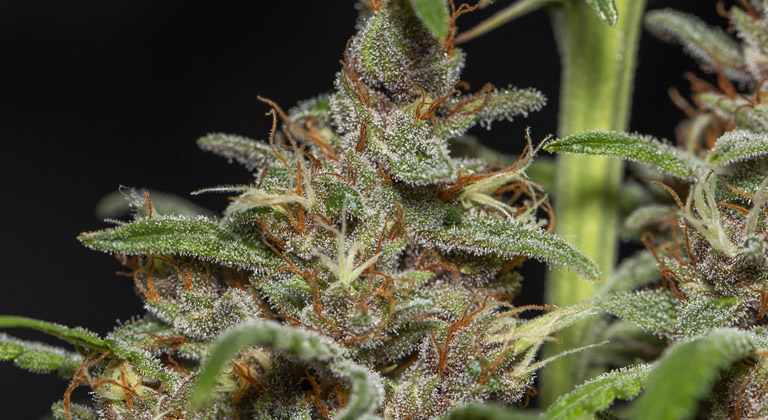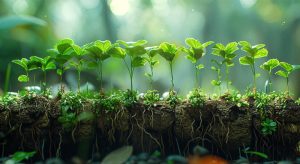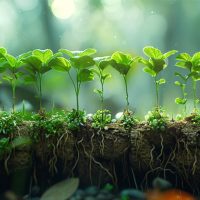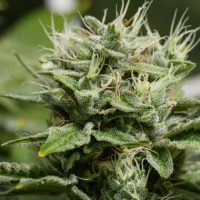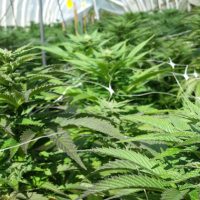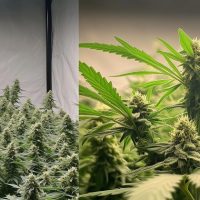The Key to Purple, Blue and Orange Pigments in Cannabis
Cannabis enthusiasts revel in the visual spectacle that some strains offer – visually pleasing plants that captivate with the beauty of their purple, reddish, and even bluish hues.
Next, we’ll explain why genetics, chemistry, and the environment influence the color palette of cannabis and what this means for growers and enthusiasts of this plant.
Chlorophyll and its Role in the Color of Cannabis Plants
Chlorophyll is the pigment responsible for the characteristic green color of cannabis plants. Moreover, it’s an essential element for photosynthesis, the process by which plants convert sunlight into energy. Chlorophyll is found in the chloroplasts of plant cells and is crucial for light absorption.
Function of chlorophyll in photosynthesis
Photosynthesis involves the capture of sunlight by chlorophyll, which is then used to synthesize glucose and oxygen. Without chlorophyll, the plant cannot carry out this vital process. This compound is the reason why the leaves and stems of cannabis plants are green — they are filled with chlorophyll.
The green color of chlorophyll comes from its ability to absorb light in the blue and red regions of the spectrum and reflect green light. When chlorophyll is abundant, the plant appears green. Therefore, this color is essential for the efficiency of photosynthesis, maximizing the absorption of light necessary for energy production.

Anthocyanins: the Magic Behind the Colors in Cannabis Plants
Many wonder what lies behind the striking colors of some cannabis strains that differ from green. The compounds responsible for this colorful beauty are anthocyanins.
In reality, anthocyanins are flavonoids with antioxidant properties found in various parts of the plant, including flowers and leaves.
Factors that Trigger the Production of Anthocyanins in Cannabis Plants
Exposure to cold temperatures and variation in soil pH can stimulate the production of anthocyanins in cannabis plants. When temperatures drop at night, anthocyanins accumulate in cells, resulting in more intense and vibrant colors.
What Colors Do each Compound Produce?
Behind the production of the different colors that different cannabis strains can offer, there are specific compounds responsible. Below, we detail which substances are behind each color, including purple, blue and orange.
Variation in Greenish Tones: Different Types of Chlorophyll💚
There are several types of chlorophyll, but chlorophyll A and B are the most common in cannabis plants. The amount of these types of chlorophyll in a cannabis plant can influence the intensity of the green color.
Chlorophyll A absorbs light better in the red region, while chlorophyll B does so in the blue region. The relative amount of these pigments can vary depending on the plant’s genetics and growing conditions. This explains why some plants have a more intense green color than others.
Carotenoids, and Yellow and Orange Tones in Cannabis💛🧡
Carotenoids are responsible for yellow and orange colors in some cannabis strains. Their concentration varies depending on genetic and environmental factors.
These pigments are crucial for photosynthesis, but when conditions are unfavorable for this process, carotenoids can become more visible, resulting in yellow or orange leaves. This can happen, for example, in autumn.
Anthocyanins, and Purple and Blue Tones in Cannabis💙💜
We’ve already explained above what anthocyanins are, but what we haven’t revealed is that these compounds generate purple and blue colors in cannabis plants. Which means that they’re responsible for the beauty of many strains that display mysterious purple, dark, and bluish tones – intriguing!

The Influence of Genes: Inheritance of Colors in Cannabis Plants
Genetic inheritance in relation to the colors displayed by cannabis strains follows complex patterns. Some strains have a genetic predisposition to produce certain colors; for example, strains like Purple#1 by Dutch Passion or Purple Punch by Seedstockers often have genes that are encoded to favor the production of anthocyanins.
As a result, some cannabis breeders have used selective crosses for generations to develop strains with specific colors. This involves selecting plants with the desired color characteristics and breeding them, leading to the creation of strains famous for their distinctive tones.
Genetic Mutations and Unusual Colors
However, although it may not be the goal of the selection and breeding process by seed bank breeders, spontaneous genetic mutations can “accidentally” occur, resulting in unusual colors in cannabis plants. These mutations may be rare but can be of great interest to collectors of unusual strains. A good example of this are the Freakshow or Supafreak strains from Humboldt Seeds Company, which come from breeding a strange strain from Australia (Australian Bastard Cannabis), or the case of Frisian Duck and Auto Duck, which result from crosses with the rare Duckfoot.
Environmental Factors Influencing Purple, Blue and Orange Cannabis Colors
Genetic predisposition is not the only factor that can cause cannabis plants to display unusual colors; certain environmental parameters can also influence them.
Relationship Between Light and Pigment Production
The quantity and quality of light a cannabis plant receives can affect pigment production. Intense light tends to favor chlorophyll formation, while dim light can stimulate the production of anthocyanins. Full-spectrum lights, including blues and reds, are ideal for maintaining a balance in pigment production.
How Temperature can Affect the Color of Cannabis
If your cannabis plants are exposed to low temperatures, this could promote the formation of anthocyanins and, therefore, the appearance of darker colors in leaves and flowers. On the other hand, high temperatures can inhibit pigment production, leading to greener and duller colors.
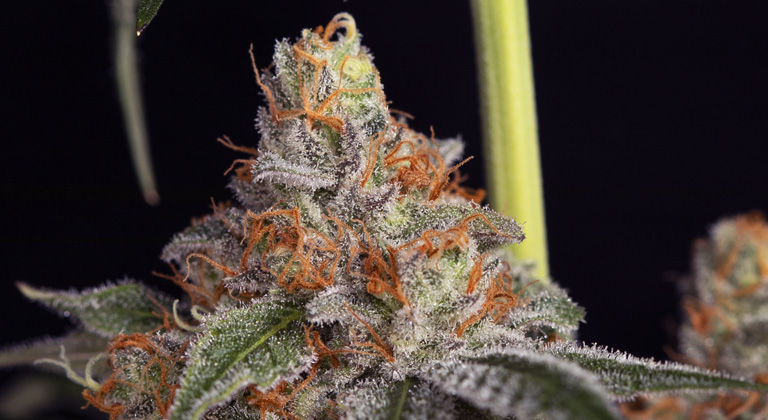
Growing Techniques to Influence Cannabis Colors
It’s possible to promote more purple, reddish, or dark colors by manipulating light and temperature, creating optimal conditions for specific pigments. This is often achieved in the flowering stage, where strategies are applied to intensify the desired colors.
The most common method is exposing cannabis plants to low temperatures during the dark period. To do this, this technique must be carefully controlled, maintaining temperatures around 19 degrees Celsius (during the night or when the lights are off), as temperatures below these parameters could affect the development and growth of the plants.
Influence of Nutrients and Soil pH on Cannabis Pigmentation
Nutrients such as phosphorus and potassium are essential for pigment production in cannabis plants. If there is a deficiency of any nutrients during the growing process, for whatever reason, this could negatively impact pigmentation, resulting in pale and abnormal colors in the plant’s leaves.
Soil Acidity and its Effect on Cannabis Colors
Incorrect soil pH can block the absorption of necessary nutrients for pigment production (among other processes), affecting the color of the plant. Maintaining a balanced pH is crucial to ensure vibrant colors.
Tips for Proper Nutrient and pH Management
To ensure that cannabis plants look healthy with varied and vibrant colors, it’s important to measure soil pH and adjust nutrient and pH levels as needed to optimize pigmentation. This can be achieved by choosing the right fertilizers and other products that affect soil quality and health, such as enzymes or mycorrhizae.
Perception of Cannabis Quality Based on Bud Color
Although the color of buds can influence the perception of quality, it’s not necessarily an indicator of cannabis potency. The production of cannabinoids and terpenes in cannabis is actually more related to genetics and their overall care; brightly colored buds can be equally potent and aromatic as green ones.
Popular Beliefs About Effects Associated with Different Colors in Cannabis
Some people believe that bud colors can have different effects. For example, some consumers associate red colors with a more relaxing effect and green colors with energetic sensations.
However, this is not supported by science, and the effects are more influenced by strain genetics, harvest timing (more maturity equals a stronger narcotic effect), and primarily the terpene profile of each strain.

Conclusion
In this journey through the science of colors in cannabis plants, we have discovered how genetics, chemistry, and the environment play a fundamental role in the purple, yellow, blue and orange color palette that cannabis plants can offer. From the vibrant green of chlorophyll to the deep tones of anthocyanins, each cannabis plant is unique in its chromatic expression.
This diversity is not only fascinating from a scientific standpoint, but also has significant implications for consumers and growers.
Do you have any questions about colors in cannabis plants? Feel free to check our frequently asked questions below!
Frequently Asked Questions about Cannabis Colors
- Is it true that red cannabis plants are more potent?
Not necessarily. The color of cannabis plants is not directly related to their strength. The intensity of the psychoactive effect produced by cannabis is more influenced by the strain’s genetics and its cannabinoid content, such as THC and CBD.
- Can I change the color of my cannabis plant by adjusting the light?
Yes, light is an important factor in influencing the color of cannabis plants. You can experiment with full-spectrum lights and variations in light duration to stimulate the production of desired pigments.
- Which cannabis strains are more prone to have striking colors?
Strains known as “Purple” often have a genetic predisposition to produce purple or violet colors. However, other strains can also display intense colors under the right conditions.
- Do anthocyanins have any health benefits?
Yes, anthocyanins are antioxidants that can have benefits, such as protection against oxidative stress. However, the concentration of anthocyanins in cannabis plants is generally low compared to other foods rich in these compounds.
- How can I prevent my cannabis plants from turning yellow during cultivation?
Yellowing of plants may be due to nutrient deficiencies, such as iron or nitrogen unless it occurs at the end of flowering. It’s important to maintain a proper balance of fertilization and ensure that the soil pH is in the optimal range for nutrient absorption.
What did you think of this post? Interesting, right? Leave your comment with any questions or opinions you want to share with the community below!
La Huerta Grow Shop
